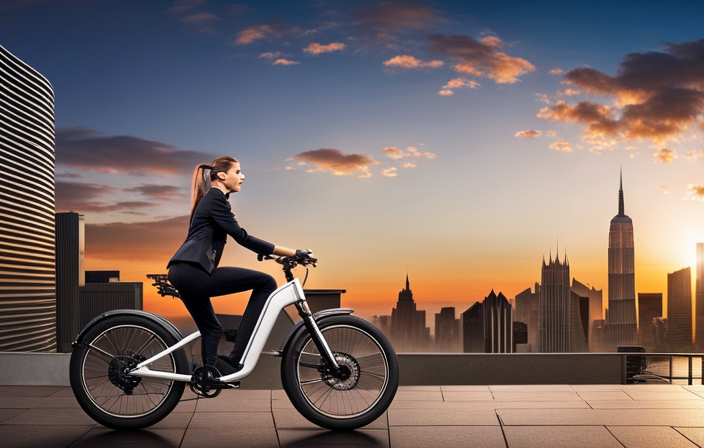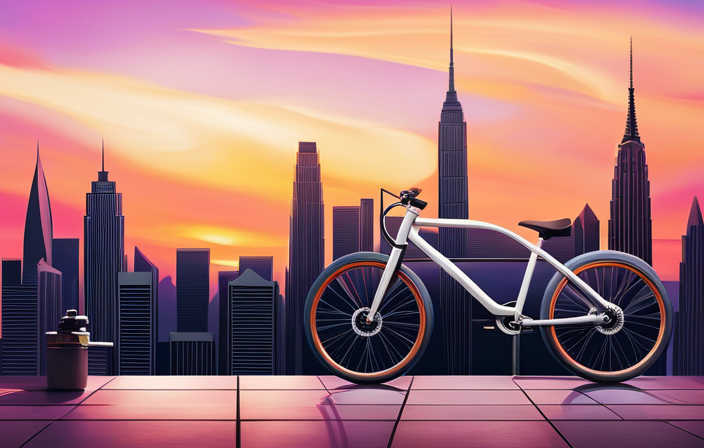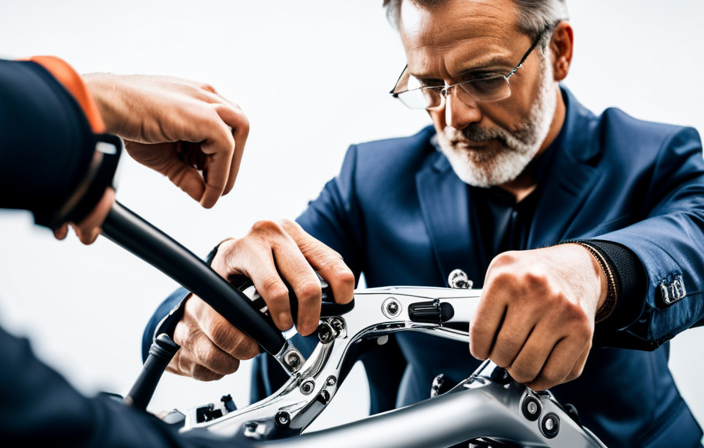Envision gliding smoothly through urban roads, feeling the breeze flowing through your hair and a grin spread across your face. This is the thrill that comes with owning a class 3 electric bike. Perfect for both daily commutes and venturing into uncharted paths, these advanced e-bikes deliver an adrenaline-pumping experience with speeds reaching up to 28 mph.
But what exactly is a class 3 electric bike, and what sets it apart from other types of e-bikes? In this article, we’ll delve into the world of class 3 electric bikes, exploring their benefits, regulations, safety considerations, and more.
Get ready to embrace a new level of riding experience!
Key Takeaways
- Class 3 electric bikes have a top speed of 28 mph
- They are equipped with a pedal-assist system for added power
- Class 3 electric bikes comply with specific regulations and safety standards
- They provide an exhilarating and efficient riding experience
What is an Electric Bike?
If you’ve ever wanted to feel the exhilaration of effortlessly cruising through the streets, a class 3 electric bike is the answer to your dreams.
Electric bikes, also known as e-bikes, have gained popularity in recent years due to their numerous advantages. One of the main advantages is the ease of mobility they offer, allowing riders to effortlessly navigate through traffic or climb steep hills. Thanks to advancements in electric bike technology, these bikes now come equipped with powerful motors and long-lasting batteries, providing a smooth and efficient ride.
With the ability to reach speeds of up to 28 miles per hour, class 3 electric bikes offer a thrilling experience for riders of all skill levels. Understanding different classes of electric bikes allows riders to choose the one that best suits their needs.
So, let’s dive into the details of these classes and explore the exciting world of electric biking.
Understanding Different Classes of Electric Bikes
When you ride a class 3 e-bike, you’ll feel an exhilarating rush of speed and power as you effortlessly glide through city streets and conquer steep hills.
Class 3 electric bikes are a step up from class 1 and class 2 e-bikes in terms of speed and performance. The main difference between class 1 and class 2 e-bikes lies in their motor assistance.
Class 1 e-bikes provide pedal-assist up to 20 mph, while class 2 e-bikes have a throttle that can propel them up to that same speed without pedaling.
Class 3 e-bikes, on the other hand, offer pedal-assist up to 28 mph, making them faster and more suitable for longer commutes or recreational rides. The benefits of pedal assist include reduced fatigue, increased range, and a more enjoyable riding experience.
Transitioning into the subsequent section about benefits of class 3 electric bikes, these features make them a popular choice among commuters and adventure seekers alike.
Benefits of Class 3 Electric Bikes
Looking to conquer steep hills and effortlessly glide through city streets? Imagine the exhilarating rush of speed and power you’ll feel on a class 3 e-bike.
Class 3 electric bikes are equipped with advanced electric bike technology, providing a boost of speed up to 28 miles per hour. This means you can keep up with traffic and cover longer distances in less time.
Not only do class 3 e-bikes offer a thrilling ride, but they also come with numerous health benefits. Riding a class 3 e-bike can improve cardiovascular fitness, increase muscle strength, and enhance overall endurance. It’s like having your own personal trainer on wheels!
Now, let’s dive into the regulations and restrictions for class 3 electric bikes, ensuring you ride safely and legally on the road.
Regulations and Restrictions for Class 3 Electric Bikes
Now, let’s explore the regulations and restrictions that govern the use of these high-speed e-bikes on the road. Class 3 electric bikes are subject to certain regulations to ensure safety and compliance with traffic laws. One of the key regulations is the speed limit. In most areas, class 3 electric bikes are limited to a top speed of 28 miles per hour. This limit is imposed to maintain the safety of riders and other road users. Additionally, some regions require riders to be at least 16 years old and wear a helmet while operating a class 3 electric bike. It’s important to check the specific regulations in your area as they may vary. Understanding and following these regulations is crucial for a smooth and legal ride. Moving forward, let’s discuss the safety considerations for riding a class 3 electric bike.
Safety Considerations for Riding a Class 3 Electric Bike
When riding a Class 3 electric bike, there are several safety considerations that should be taken into account.
First and foremost, it is crucial to always wear a helmet and other protective gear to protect yourself in case of a fall or accident.
Additionally, it is important to familiarize yourself with traffic laws and bicycle etiquette, as Class 3 electric bikes can reach higher speeds and may require different handling than traditional bicycles.
Finally, regular maintenance and inspection of your electric bike is essential to ensure that it is in proper working condition and to prevent any potential malfunctions while on the road.
Helmet and Protective Gear
Wearing a helmet and protective gear is essential when riding a class 3 electric bike. Not only does it protect your head in case of a fall or collision, but it also helps increase visibility and makes you more noticeable to other road users. When choosing a helmet, make sure it fits snugly and meets safety standards. Look for features like adjustable straps, ventilation, and a visor to shield your eyes from the sun. As for protective gear, consider wearing knee and elbow pads, as well as gloves to protect your hands in case of a fall. To help you choose the right gear, here’s a table highlighting some important factors to consider:
| Helmet Safety | Protective Gear Selection |
|---|---|
| Meets safety standards | Comfortable fit |
| Adjustable straps | Knee and elbow pads |
| Ventilation | Hand protection |
Now that you’re equipped with the right gear, let’s move on to the next section about traffic laws and bicycle etiquette.
Traffic Laws and Bicycle Etiquette
Navigating through traffic and following bicycle etiquette can be as smooth as riding on a summer breeze if you know the rules of the road. When riding a class 3 electric bike, it’s important to prioritize bicycle safety and be aware of your surroundings.
Sharing the road with cars requires extra caution and adherence to traffic laws. Always use hand signals to indicate your intentions and make sure to ride in a predictable manner. It’s crucial to obey traffic lights and stop signs, just like any other vehicle on the road. Additionally, maintain a safe distance from parked cars to avoid accidents caused by opening doors.
Remember to be courteous to other road users and yield the right of way when necessary. By following these guidelines, you can ensure a safe and enjoyable ride.
Speaking of safety, let’s move on to the next section about maintenance and inspection.
Maintenance and Inspection
To ensure a smooth and safe ride, it’s crucial for riders to regularly inspect and maintain their bicycle. Here are three key maintenance and inspection tasks every class 3 electric bike owner should know:
-
Check the tire pressure: Proper tire pressure improves performance and reduces the risk of flats. Use a pressure gauge to ensure the tires are inflated to the manufacturer’s recommended level.
-
Lubricate the chain: A well-lubricated chain improves shifting and extends its lifespan. Apply a bicycle-specific lubricant to the chain, wipe off any excess, and ensure it moves smoothly.
-
Inspect the brakes: Check the brake pads for wear and replace if necessary. Ensure the brake levers engage and disengage properly, and adjust the brake cables if needed.
By performing these maintenance tasks regularly, riders can keep their class 3 electric bikes in optimal condition.
Now let’s move on to choosing the right class 3 electric bike for you, taking into consideration your specific needs and preferences.
Choosing the Right Class 3 Electric Bike for You
When it comes to choosing the right class 3 electric bike for me, there are a few key points I need to consider.
First, the frame and design of the bike play a crucial role in determining its comfort and stability. I want to make sure I find a bike with a sturdy frame and a design that suits my riding style.
Second, battery life and range are important factors to consider, as they determine how far I can go on a single charge. I’ll need to find a bike with a reliable battery that offers a decent range for my daily commute or recreational rides.
Lastly, I’ll look for additional features and accessories that enhance my riding experience, such as built-in lights, fenders, or a rack for carrying my belongings. These features can make a big difference in the convenience and functionality of the bike.
Frame and Design
With its sleek and stylish frame, a class 3 electric bike seamlessly combines form and function to create an exhilarating riding experience. When considering a class 3 electric bike, it’s important to pay attention to the bike materials and frame geometry.
The frame of a class 3 electric bike should be made from lightweight yet durable materials such as aluminum or carbon fiber, ensuring both strength and agility. Additionally, the frame geometry should be designed to provide stability and control, allowing riders to confidently navigate various terrains.
Now, let’s shift our focus to another crucial aspect of class 3 electric bikes: battery life and range.
Battery Life and Range
Get ready to experience the freedom and exhilaration of riding for miles on end with a battery that never quits on you.
The battery life and range of a Class 3 electric bike are essential factors to consider when purchasing one. Thanks to advancements in battery technology, Class 3 electric bikes can now offer longer battery life and extended ranges.
With a reliable battery, you can confidently embark on long rides without worrying about running out of power. Additionally, the charging infrastructure for electric bikes is constantly improving, making it easier to find charging stations along your route. This ensures that you can quickly recharge your bike and continue your journey with minimal downtime.
As we move on to the next section about additional features and accessories, you’ll discover even more reasons to fall in love with Class 3 electric bikes.
Additional Features and Accessories
Imagine the thrill of personalizing your ride with a wide range of accessories, such as stylish baskets and panniers, to make your journey as convenient and fashionable as possible. Did you know that 80% of Class 3 electric bike owners choose to customize their bikes with accessories that enhance both functionality and style? These electric bike accessories are designed to cater to the needs of riders, providing advanced technology features and ensuring a comfortable and enjoyable experience. From high-quality lights and mirrors for enhanced safety, to phone holders and Bluetooth speakers for added convenience, these accessories take your electric bike to the next level. Additionally, there are options for saddlebags and cargo carriers to help you carry your belongings effortlessly. By personalizing your Class 3 electric bike with these accessories, you can truly make it your own. Now, let’s delve into some tips for riding and maintaining a Class 3 electric bike.
Tips for Riding and Maintaining a Class 3 Electric Bike
Maintaining a Class 3 electric bike is crucial for ensuring a smooth and enjoyable riding experience. To make the most out of your ride, here are some essential tips:
-
Master your riding techniques: Familiarize yourself with the bike’s speed and handling capabilities. Practice braking, cornering, and maneuvering in different road conditions.
-
Take care of your battery: Regularly charge your battery and avoid letting it fully deplete. Store it in a cool and dry place when not in use. Check the battery connections and clean them if necessary.
-
Keep your bike clean: Regularly wipe down your bike to remove dirt and grime. Pay special attention to the chain, gears, and brakes. Lubricate the chain to ensure smooth operation.
-
Inspect and maintain your bike: Check the tire pressure, brakes, and gears regularly. Tighten any loose bolts and ensure all components are in good working order.
By following these tips, you can ensure a safe and enjoyable ride on your Class 3 electric bike.
Transitioning to the next section, let’s now compare this mode of transportation with others.
Comparison with Other Modes of Transportation
When comparing a Class 3 electric bike to other modes of transportation, you’ll be amazed to know that on average, electric bikes are 10 times more energy efficient than cars. Not only are they eco-friendly, but they also offer numerous benefits compared to traditional bicycles. Electric bikes provide assistance when pedaling, making them easier to ride and allowing riders to cover longer distances with less effort. This makes them a great option for commuting, especially in hilly areas or for people who may not be able to exert themselves as much due to physical limitations. Additionally, electric bikes have a positive impact on personal fitness, as they still require some pedaling effort to operate. They provide a low-impact workout that can improve cardiovascular health and help to build muscle strength.
| Mode of Transportation | Energy Efficiency | Impact on Personal Fitness |
|---|---|---|
| Class 3 Electric Bike | 10 times more | Improves cardiovascular |
| energy efficient | health and builds muscle | |
| Traditional Bicycle | ||
| Car | ||
As you can see from the table above, electric bikes outperform traditional bicycles in terms of energy efficiency while still providing health benefits. Now, let’s delve into some real-life examples and testimonials to further understand the impact of Class 3 electric bikes.
Real-Life Examples and Testimonials
Have you ever heard someone say that riding an e-bike feels like flying? Well, let me tell you, it’s true! I’ve had the pleasure of trying out a class 3 electric bike and it was an exhilarating experience. Here are some real-life examples and testimonials that showcase the incredible performance of these bikes:
- Unbelievable speed: With a top speed of up to 28 miles per hour, you can zip through city streets with ease.
- Effortless climbing: Hills become a breeze as the powerful motor assists you in conquering any incline.
- Extended range: Some riders have reported traveling up to 60 miles on a single charge, making longer commutes a viable option.
- Smooth acceleration: The motor seamlessly kicks in to provide a boost of power, allowing for quick and efficient acceleration.
These real-life experiences and performance comparisons truly highlight the capabilities of class 3 electric bikes.
Now, let’s dive into the next section and explore their environmental impact and sustainability.
Environmental Impact and Sustainability
Now that we have explored real-life examples and testimonials of Class 3 electric bikes, let’s delve into their environmental impact and sustainability. One of the significant advantages of these bikes is their carbon footprint reduction. By replacing traditional gasoline-powered vehicles with electric bikes, we can significantly decrease our carbon emissions, leading to a cleaner and greener environment. Additionally, Class 3 electric bikes can integrate renewable energy sources, such as solar or wind power, to charge their batteries. This not only reduces our dependence on non-renewable energy but also contributes to a more sustainable transportation system. To emphasize the importance of this environmental impact, let’s take a look at the following table:
| Benefits of Class 3 Electric Bikes |
|---|
| Reduced air pollution |
| Decreased greenhouse gas emissions |
| Enhanced energy efficiency |
| Improved noise pollution |
| Efficient use of renewable energy |
As we move forward, it is crucial to explore future trends and innovations in Class 3 electric bikes and their potential to revolutionize transportation.
Future Trends and Innovations in Class 3 Electric Bikes
Moving into the future, we can expect Class 3 electric bikes to undergo groundbreaking advancements that will revolutionize the way we commute. Their potential to soar to new heights, like a soaring eagle, is truly exciting.
As technology continues to advance, we can anticipate exciting future innovations in Class 3 electric bikes. One area of focus will be on improving battery efficiency. This will allow for longer rides and faster charging times, making electric bikes even more convenient and practical.
Additionally, there will likely be advancements in motor power and torque. This means riders can expect increased speed and performance, providing a thrilling experience while still being environmentally friendly.
These innovations will have a significant impact on transportation, offering a greener and more sustainable alternative to traditional vehicles. With the ability to reach higher speeds, Class 3 electric bikes will become even more practical for daily commuting. This will reduce traffic congestion and carbon emissions, benefiting both individuals and the environment.
As we look to the future, the possibilities for Class 3 electric bikes are endless. In the next section, we will explore frequently asked questions about Class 3 electric bikes, providing valuable insights and information.
Frequently Asked Questions about Class 3 Electric Bikes
Class 3 electric bikes are becoming increasingly popular. However, there are some common questions that arise regarding their legality, range, and where they can be ridden. Let’s dive into these frequently asked questions.
First, are class 3 electric bikes legal? Yes, they are legal in many states and countries. However, it’s important to check the specific regulations in your area.
Secondly, how far can you travel on a single charge? The range depends on various factors such as battery capacity, terrain, and rider weight. Generally, class 3 electric bikes can travel anywhere from 40 to 100 miles on a single charge.
Lastly, can you ride a class 3 electric bike on bike paths? The rules vary by location. In some places, class 3 electric bikes are allowed on bike paths, while in others, they may be restricted to roads or designated cycling lanes.
Are Class 3 Electric Bikes Legal?
Are you aware of the legal status of Class 3 electric bikes?
Class 3 electric bikes are a specific type of electric bike that falls under the electric bike classification system. These bikes are equipped with a motor that provides assistance up to a speed of 28 miles per hour. However, there are legal restrictions that come with owning and operating a Class 3 electric bike.
In most areas, these bikes are considered to be motor vehicles and are subject to the same rules and regulations as other motorized vehicles. This means that you may be required to have a license, register the bike, and follow certain traffic laws. It’s important to familiarize yourself with the specific laws in your area before purchasing a Class 3 electric bike.
Now, let’s move on to the next topic: how far can you travel on a single charge?
How Far Can You Travel on a Single Charge?
When it comes to the range of a Class 3 electric bike, there are several factors to consider. The most important factor is the battery capacity, as it determines how much power the bike can store. Typically, Class 3 electric bikes have battery capacities ranging from 400Wh to 700Wh, which can provide a decent range for most riders.
However, it’s important to note that the actual range can vary depending on various factors such as the rider’s weight, terrain, speed, and level of pedal assistance. For example, if you’re riding on hilly terrain or using high levels of pedal assistance, your range may be reduced. On the other hand, if you’re riding on flat terrain and using minimal pedal assistance, you may be able to achieve a longer range.
So, it’s crucial to consider these factors when estimating how far you can travel on a single charge with a Class 3 electric bike.
- Factors affecting range:
- Rider weight
- Terrain
- Speed
- Level of pedal assistance
Now, let’s explore whether you can ride a Class 3 electric bike on bike paths.
Can I Ride a Class 3 Electric Bike on Bike Paths?
You can ride a Class 3 e-bike on bike paths, as long as you follow the rules and regulations set by local authorities.
Bike path rules may vary depending on the location, so it’s important to familiarize yourself with them before hitting the road. Generally, you should adhere to a maximum speed limit of 20 mph and yield to pedestrians.
It’s also crucial to exercise caution and use safety measures such as wearing a helmet and using lights or reflectors, especially when riding during low light conditions.
By following these rules and taking necessary precautions, you can enjoy the convenience and efficiency of riding a Class 3 electric bike while ensuring the safety of yourself and others around you.
Embracing the benefits of class 3 electric bikes allows you to experience a faster and more eco-friendly mode of transportation.
Conclusion: Embracing the Benefits of Class 3 Electric Bikes
To fully experience the benefits of Class 3 electric bikes, don’t hesitate to embrace their speed and efficiency, as they can easily keep up with traffic and help you arrive at your destination faster. Class 3 electric bikes are a great option for those looking for a faster and more convenient way to travel. When choosing the right Class 3 electric bike, consider factors such as battery range, motor power, and overall design. Compared to other modes of transportation, Class 3 electric bikes offer a range of advantages. They are more affordable and eco-friendly than cars, and they provide a healthier alternative to public transportation. Additionally, Class 3 electric bikes can be ridden on bike paths in many areas, making them a versatile option for commuting and recreational use. Embracing the benefits of Class 3 electric bikes is a smart choice for anyone seeking a convenient, efficient, and environmentally friendly mode of transportation. For further information and references, please consult the additional resources below.
Additional Resources and References
For further information on the benefits and features of Class 3 electric bikes, check out the additional resources and references provided below.
These resources can provide you with more in-depth knowledge about Class 3 electric bikes and help you make an informed decision. Helpful websites such as ElectricBikeReview.com and Electrek.co offer comprehensive reviews, comparisons, and guides to assist you in understanding the various options available.
You can also find valuable information on the websites of reputable electric bike manufacturers like Specialized, Trek, and Giant. These resources will give you a better understanding of the technical specifications, performance capabilities, and overall benefits of Class 3 electric bikes.
With this knowledge, you’ll be well-prepared to explore where to buy and test ride Class 3 electric bikes, which will be discussed in the next section.
Where to Buy and Test Ride Class 3 Electric Bikes
Now that you have a good understanding of what a class 3 electric bike is and where to find additional resources, let’s dive into the exciting topic of where to buy and test ride these bikes. As a buyer, it’s important to have a guide to help you make an informed decision.
To assist you, I have compiled a list of the top 5 class 3 electric bikes that you can consider.
Here are the top 5 class 3 electric bikes:
- Bike 1: [Brand and model]
- Bike 2: [Brand and model]
- Bike 3: [Brand and model]
- Bike 4: [Brand and model]
- Bike 5: [Brand and model]
These bikes have been selected based on their performance, features, and customer reviews. By test riding these bikes, you can get a feel for their handling, comfort, and overall experience.
So, let’s explore where you can buy and test ride these top class 3 electric bikes.
Frequently Asked Questions
Are Class 3 electric bikes legal everywhere?
Class 3 electric bikes are not legal everywhere. Electric bike regulations vary by location, and some places have restrictions on class 3 electric bikes. It is important to research local laws and regulations before riding one.
How fast can a Class 3 electric bike go?
Class 3 electric bikes can reach top speeds of up to 28 mph. However, it’s important to note that safety regulations vary by location. Riders must comply with local laws, including helmet requirements and age restrictions, to ensure safe and legal riding.
Can I ride a Class 3 electric bike on bike paths and trails?
Yes, you can ride a class 3 electric bike on bike paths and trails. However, it’s important to follow riding etiquette and be considerate of other trail users. The benefits of class 3 electric bikes include increased speed and efficiency for commuting and recreational riding.
Do I need a driver’s license to ride a Class 3 electric bike?
No driver’s license is required to ride a class 3 electric bike. However, it’s crucial to follow safety regulations, such as wearing a helmet and obeying traffic laws. Always prioritize safety over speed when zipping around on these powerful two-wheelers.
Are there any age restrictions for riding a Class 3 electric bike?
Yes, there are age restrictions for riding a class 3 electric bike. The specific age requirements may vary by location, but typically riders need to be at least 16 years old. Safety measures such as wearing a helmet are also important.
Conclusion
In conclusion, after exploring the world of Class 3 electric bikes, it’s clear that these powerful machines offer a thrilling and efficient way to navigate through city streets and beyond.
With their increased speed and range, Class 3 electric bikes provide a fantastic alternative to traditional bicycles and even cars.
So why not take the plunge and hop on board the Class 3 electric bike train? As the saying goes, ‘Don’t miss the boat!’
Embrace the future of transportation and experience the freedom and excitement that Class 3 electric bikes have to offer.









